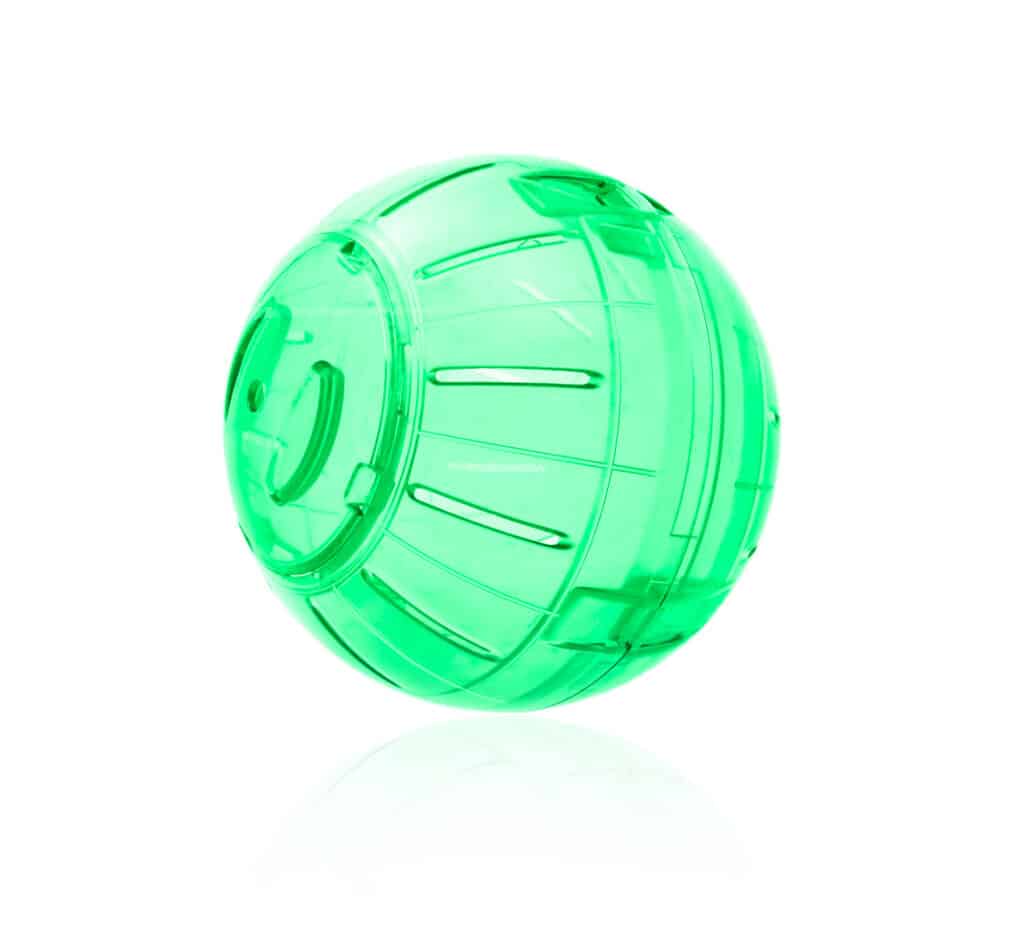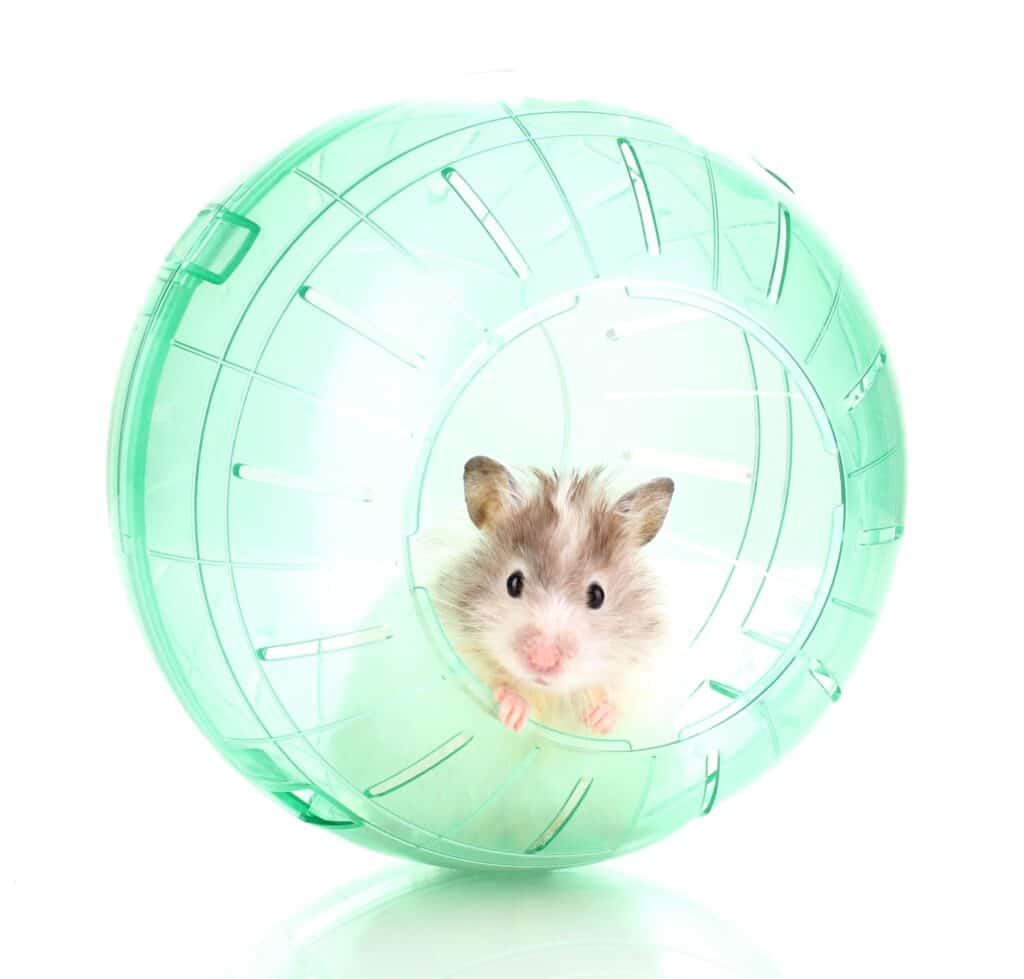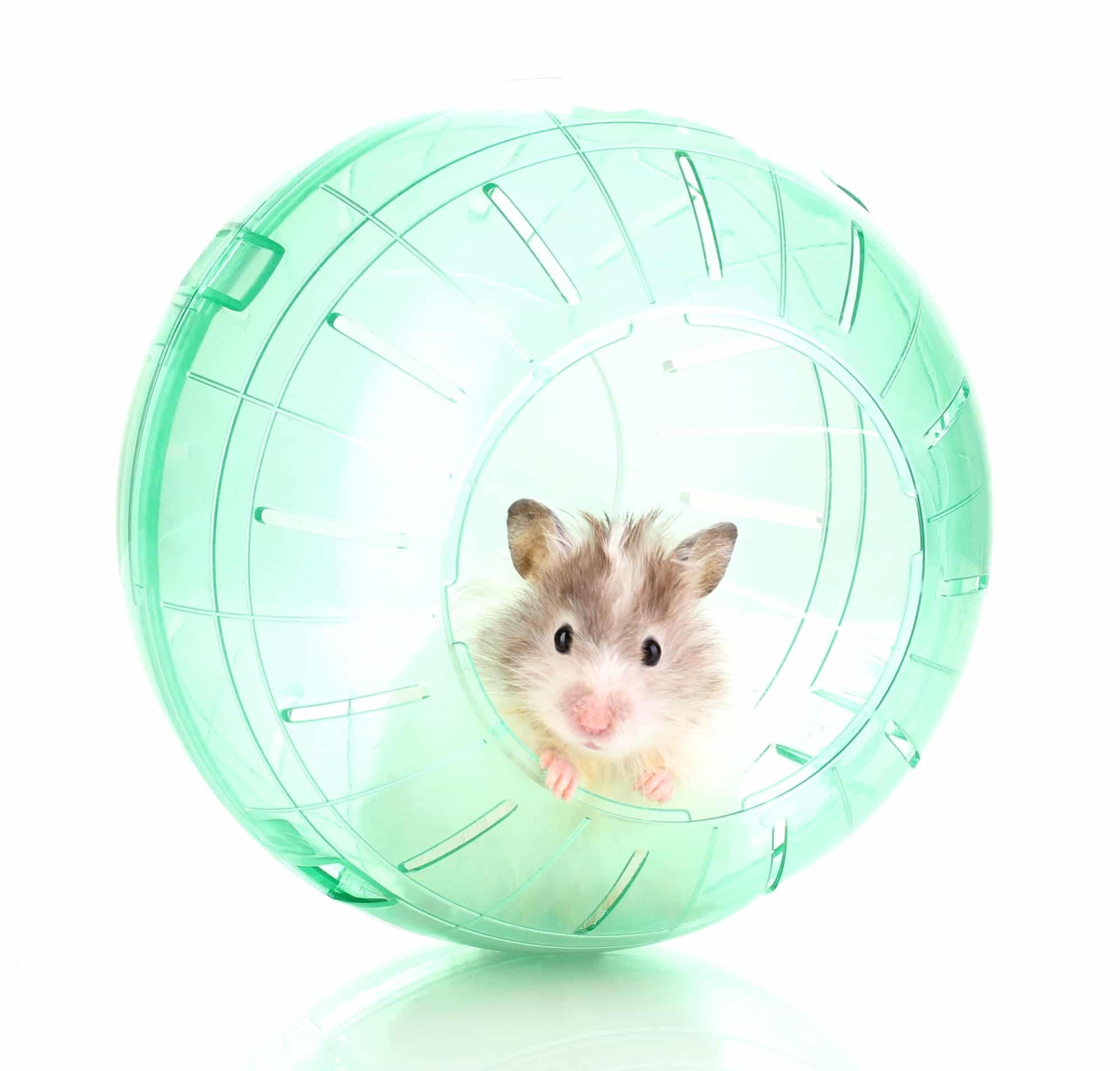Hamsters are tiny creatures that keep running all the time. Roborovski hamsters, one of the five common species of hamsters kept as pets, can run up to 6 miles in a single night in the wild. So, hamsters need a big cage to simulate their natural environment. Besides a big cage, a hamster ball can also help a hamster exercise and remain active. But are hamster balls safe? What should you look for in a hamster ball? Read this blog post to find out.
Hamster ball
What is a hamster ball?
If you’ve ever been to a circus, you might have seen the globe of death – A mesh sphere in which stunt riders ride motorcycles and at times, even cars.
A hamster ball is similar to it, with the only difference being that it is mobile. A hamster ball is a hollow sphere normally made of hard, almost-transparent plastic. It has an opening through which you can put your hamster inside or take him out of the ball.

A hamster ball is a great tool for a hamster to explore his surroundings without getting lost. It has air holes. So you don’t have to worry about your hamster suffocating in it.
Can you use a hamster ball?
What are the benefits of using a hamster ball?
- Even if you have a hamster cage that is big enough (the recommended minimum size is 24″ x 12″ x 12″), it is still not comparable to a hamster’s habitat in the wild. But taking your hamster outside and letting him play outside might give him a taste of the natural habitat his wild counterparts are used to. It will also satisfy his curious mind.
- But if you let your hamster roam around on the floor of your house, you don’t know what he might do. He might eat the dust particles on the floor, or he might chew a wire and get an electric shock. A hamster ball prevents these from happening by creating a safe enclosure where your hamster can explore his surroundings without endangering himself or others.
- If you let your hamster out on the floor of your house, he may run away and hide. Then finding your hamster will be a big problem. But hamster balls produce a rumble that is audible on most surfaces. So, you can easily find out where your hamster is even if you cannot see him.
What are the dangers of using a hamster ball?
- The main problem with using a hamster ball is that your hamster has no control over where the ball is going. So, he might bump into walls or fall down the stairs and injure himself.
- If the hamster ball is too small for your hamster, it can damage his back.
- A hamster ball is a cramped area. So, if your hamster feels scared, there is no way for him to escape or hide.
- A hamster may pee and poop while running on the ball. Since a hamster ball is a small enclosure, your hamster might end up stamping on his own pee and poop. If your hamster does this every day, it can affect his health.
- Hamsters need an optimal temperature range of 18°C to 24°C to live healthily. You may have a thermostat in the room to ensure that the temperature remains within this range at all times. However, inside the hamster ball, as your hamster runs and breathes out Carbon dioxide, the air can become hotter quickly. But since there isn’t a big opening (since it only has air holes) inside the ball for the hot air to go outside and cold air to come inside, the inside of the hamster ball can get pretty hot, making it difficult for your hamster to breathe.
Should you use a hamster ball or not?
Even though a hamster ball appears to be dangerous at first glance, it can actually be used safely if you take some precautions. So, let’s find out how to use a hamster ball safely.
How to use a hamster ball safely?
- One thing you should know before buying a hamster ball is that the hamster ball should be big enough for your hamster to run in without arching his back. If not, it can cause back pain and spinal curvatures. The hamster ball should have a minimum diameter of 12 inches for a Syrian hamster and 8 inches for a dwarf hamster.
- Even though hamster balls are safe, they cannot protect your hamster in case of a fall. So, block access to places such as stairs and elevated platforms, from which your hamster can fall and injure himself.
- Even though hamster balls have air holes for your hamster to breathe, there is no way for your hamster to drink water while he is inside a hamster ball. So, your hamster can get dehydrated quickly if he spends a lot of time inside the hamster ball. Therefore, limit the time your hamster spends in the hamster ball to 15 minutes at a time.
- As explained above, hamster balls have air holes for your hamster to breathe. But sometimes, your hamster’s poop can get stuck in these holes and block the air supply, thereby suffocating your hamster. So, you should clean the hamster ball after every use.
- The hamster ball can get too hot for your hamster. So, if you notice your hamster panting, you should take him out of the ball immediately.
- If you have bigger pets, like a cat or a dog, keep them away from the hamster ball. If not, they can kick the hamster ball and play with it, scaring your hamster.
- If you see the video below, you will notice that the ball starts spinning and the hamster is left not knowing what to do. So, never let your hamster use the hamster ball unsupervised.
How to clean a hamster ball properly?
When a hamster uses a hamster ball, he can urinate and excrete inside it. If the hamster ball is not cleaned properly, the urine and feces can deposit over time, causing not only a foul smell but also the growth of harmful pathogens, which can be dangerous for your hamster. So, clean the hamster ball properly with soap every time your hamster runs on it.
How to introduce your hamster to a hamster ball?
Your hamster might be scared the first time you put him inside a hamster ball and leave him alone. Moreover, since he is not used to running in a hamster ball, he might run out of breath soon. So, start with a couple of minutes. Then, as your hamster gets used to it and starts having fun, increase the amount of time he spends in one go. But do not let your hamster use the hamster ball for more than 15 minutes in one go. Do not let him use the hamster ball unsupervised, either.
When to take your hamster out of a hamster ball?
A hamster ball is a great way for your hamster to exercise and have fun at the same time. But sometimes, a hamster would want to get out of the hamster ball because he is tired. Moreover, some hamsters might not like hamster balls at all because it prevents them from interacting with the environment directly.
In such cases, you can observe your hamster’s behavior and find out if your hamster feels uncomfortable inside the ball. If you notice any of the following behaviors that indicate that your hamster is uncomfortable, you should take him out of the hamster ball immediately:
- If your hamster is panting too much, it is an indicator that he is either tired or having difficulty breathing, or feeling too hot inside the hamster ball.
- If your hamster squeaks too much, it can mean that your hamster is feeling scared or stressed. Also read: Why is my hamster squeaking?
- If your hamster doesn’t want to move or is hesitant to enter the ball a second time, it is an indicator that he doesn’t like to be inside the ball.
Some hamsters may not like to be inside the hamster ball at all since it robs them of the ability to interact with their surroundings. In such cases, it is better not to use a hamster ball. After all, a hamster ball is not the only thing that can keep your hamster engaged. There are other toys as well.
Alternatives to a hamster ball
- If your hamster doesn’t like to be inside a hamster ball, you can use a playpen. Make sure that the playpen is escape-proof.
- You can also keep your hamster on a sofa and play with him. Just make sure he doesn’t fall down.
- You can also create an obstacle course using cardboard boxes, ramps, and tunnels.
- You can also use a hamster wheel.
- To keep your hamster from getting bored and depressed, you can bury the treats inside his bedding. This can encourage him to burrow, which is a natural instinct that makes a hamster happy.
- Keep enough toys in the cage to prevent your hamster from getting bored.



